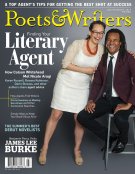Long before the Internet brought translation—and more often than not, the likelihood of mistranslation—to our fingertips, literary magazines were expanding our linguistic boundaries through modernist publications like New Directions in Poetry and Prose, transition, and Fantasy, which offered readers carefully crafted early translations of work by Jean Cocteau, Franz Kafka, and Federico García Lorca, among many others. The Old Deerfield, Massachusetts–based biannual Osiris (www.facebook.com/osiris.poetry) continues this tradition, having since 1972 published lyric poetry by hundreds of writers from around the world, including work translated from the French, Vietnamese, Walloon, Polish, and more. Founding editors Andrea and Robert Moorhead pay special attention to how the poems of each issue work together: “Each text echoes or anticipates or re-creates the texts that precede and follow it,” says Andrea Moorhead. Issue 78, featuring work by Astrid Cabral and Karl Krolow, is on newsstands now. Works in translation and original poetry in English are considered year-round via e-mail or by postal mail.
In San Francisco, the Center for the Art of Translation’s Two Lines (www.twolinespress.com/two-lines-journal) is one of the most prominent American purveyors of world literature, praised recently by the Los Angeles Review of Books for “expanding our access to literary voices that would otherwise be simply inaccessible to American readers.” The twentieth anniversary issue, “Landmarks,” coedited by Susan Bernofsky and Christopher Merrill, includes translations of work by writers from nearly two dozen countries, including poetry by Naseer Hassan of Iraq and Mona Elnamoury of Egypt. With a newly redesigned website and the recent addition of essays on translation, the publication continues to evolve, making it “an ongoing part of the conversation of translation and international literature,” says editor CJ Evans. Submissions of poetry and fiction in translation along with essays on translation are considered year-round for both the print magazine and the website via Submittable or by postal mail.
Hayden’s Ferry Review (www.english.clas.asu.edu/hfr), the semiannual journal from Arizona State University’s creative writing program, focuses on a similar conversation, offering a translator’s foreword with each piece and, for poetry, each work in its original language alongside the translation. Founded in 1986, Hayden’s Ferry Review (HFR) has regularly included works of translation in its pages for the past decade, adding two international editors to the masthead. The latest issue from outgoing editor Sam Martone, Issue 54, is particularly diverse, featuring English translations of work from Italy, Korea, and Macedonia. Martone sees publishing translation as part of what makes HFR an alternative to more traditional university journals, which he describes as having “a certain homogeneity in content.” Dana Diehl will be taking over as editor in the fall. Works in translation and original poetry, fiction, nonfiction, and art may be submitted with a three-dollar fee year-round via Submittable.
Fairleigh Dickinson University’s quarterly the Literary Review (www.theliteraryreview.org) has been a constant source of international literature and work in translation since its inception in 1957, with notable past issues focusing on Italian fiction and the literature of Hong Kong. When Minna Proctor was named editor in 2008, she began giving each issue a theme, such as “Artificial Intelligence” and “Invisible Cities.” “We wanted to be more consistent for our readers,” Proctor says, “in terms of what they can expect from the magazine each quarter, without losing the international focus.” The latest issue, “Game Theory,” includes translated work by Eduardo Chirinos and Utz Rachowski. The Literary Review considers submissions of poetry, fiction, essays, and works in translation year-round via Submittable; the theme of the forthcoming fall issue will be “Women’s Studies.”
In 2010 editor and publisher Katie Raissian launched the Brooklyn, New York–based literature and arts journal Stonecutter (www.stonecutterjournal.org) in order to bring together writers and artists from the United States and abroad “in the hopes that surprising connections between imaginations and geographies will form.” A native of Ireland, Raissian found inspiration from internationally minded American presses and journals such as Archipelago Books, Dalkey Archive Press, and A Public Space. Issue 4 features translated work by Aden Ellias, Pierre Autin-Grenier, and Bohumil Hrabal, as well as an interview with Karl Ove Knausgaard. Works in translation and original poetry, fiction, essays, plays, and art are considered year-round via Submittable.
Travis Kurowski is the editor of Paper Dreams: Writers and Editors on the American Literary Magazine, published in 2013 by Atticus Books. His website is traviskurowski.com.

Please log in to continue.
LOG IN
Don’t yet have an account?
Register for a free account.
For access to premium content, become a P&W member today.







